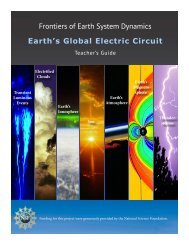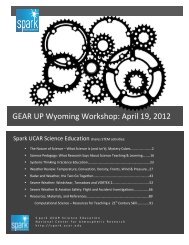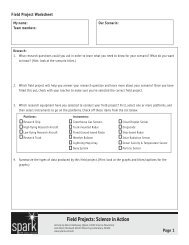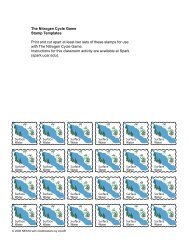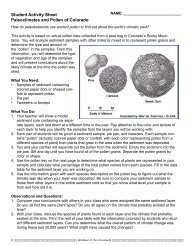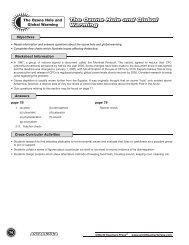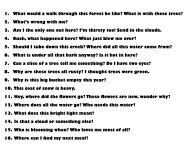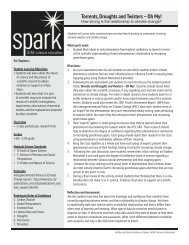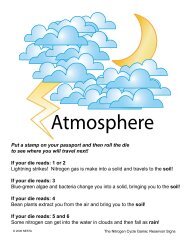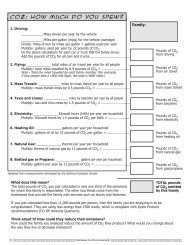#18- Air Pollution 101 Lesson Plan - Salsa!
#18- Air Pollution 101 Lesson Plan - Salsa!
#18- Air Pollution 101 Lesson Plan - Salsa!
You also want an ePaper? Increase the reach of your titles
YUMPU automatically turns print PDFs into web optimized ePapers that Google loves.
AIR POLLUTION <strong>101</strong><br />
INTRODUCTION<br />
Students will gain background knowledge of the basic sources of air pollution, along with the<br />
overview of how air pollution affects our health and our environment. They will participate<br />
in a hands-on demonstration to visually demonstrate that everyone has an impact on air<br />
pollution. Students will also write a description of each pollutant, as well develop their own<br />
ideas of the most dangerous and most significant pollutants. They will form ideas of how<br />
these pollutants can be reduced and how their air can be revitalized and the negative impacts<br />
of air pollution can be reduced.<br />
LESSON OVERVIEW<br />
Grade Level & Subject: Grades 9-12: Science<br />
Length: 1 class period<br />
Objectives:<br />
After completing this lesson, students will be able to:<br />
• Comprehend the basics of air pollution<br />
• Identify the seven main air pollutants<br />
• Describe the sources of the main air pollutants<br />
National Standards Addressed: 1<br />
This lesson addresses the following National Science Education Standards from the National<br />
Academies of Science:<br />
• Content Standard: NS.5-8.1 SCIENCE AS INQUIRY<br />
As a result of their activities in grades 9-12, all students should develop:<br />
Abilities necessary to do scientific inquiry<br />
Understandings about scientific inquiry<br />
• Content Standard: NS.9-12.5 SCIENCE AND TECHNOLOGY<br />
As a result of their activities in grades 9-12, all students should develop<br />
Abilities of technological design<br />
Understandings about science and technology<br />
• Content Standard: NS. 9-12.6 PERSONAL AND SOCIAL PERSPECTIVES<br />
As a result of their activities in grades 9-12, all students should develop an<br />
understanding of:<br />
Personal and community Health<br />
Population growth<br />
1 http://www.education-world.com/standards/national/index.shtml
Natural resources<br />
Environmental quality<br />
Natural and human-induced hazards<br />
Science and technology in local, national, and global challenges<br />
Materials Needed:<br />
• Reproducible #1 – Daily Activities<br />
• Computers with Internet access for each group or other means of researching air<br />
pollutants<br />
• 1 Clear, plastic (or small glass) jars recycled from café for each student<br />
• Liquid food coloring-set for each group or table or student, depending on teacher<br />
preference. For this lesson, we used red, green, yellow, and blue.<br />
• Ground charcoal (from pet store, or ground substance that will not dissolve in water)<br />
• Cocoa mix and lemonade drink mix (each student will need some of each mix)<br />
• Clean water<br />
• 1 Large container to hold all of students’ water once they have completed the<br />
demonstration<br />
• Newspaper articles about air quality if available (optional)<br />
Assessment:<br />
Students will be assessed through the following activities:<br />
• Participation in all activities<br />
• Group work and level of understanding of the pollutants in Activity One<br />
• Content and quality of the paper written in the extension activity<br />
LESSON BACKGROUND<br />
Relevant Vocabulary:<br />
• Carbon Monoxide: A colorless, odorless gas formed when a compound containing<br />
carbon burns incompletely because there is not enough oxygen. It is present in the<br />
exhaust gases of automobile engines and is very poisonous. 2<br />
• Lead: Heavy metal that can cause mental retardation, and increase in the rate of<br />
infections and cancer by blunting body's defense mechanisms (the immune system).<br />
Lead accumulates in blood, bones, and soft tissue and may result in damage to brain,<br />
central and peripheral nervous system, and kidneys. While its suggested threshold is 0.4<br />
part-per-million (ppm) for adults and 0.3 ppm for children, people can exhibit lead<br />
poisoning symptoms at 0.2 ppm. Lead intake can occur through water stored in lead<br />
pipes, food contaminated by lead in soil, lead-paint flakes, or motor exhaust that<br />
contains lead compounds as ant-knocking or performance enhancing additives in<br />
gasoline. 3<br />
2 The American Heritage® Science Dictionary Copyright © 2005 by Houghton Mifflin Company. Published<br />
by Houghton Mifflin Company. All rights reserved. Retrieved 05 May 2011 from<br />
http://www.thefreedictionary.com/carbon+monoxide.<br />
3 "What Is Lead (Pb)? Definition and Meaning." BusinessDictionary.com - Online Business Dictionary. Retrieved 05<br />
May 2011 from http://www.businessdictionary.com/definition/lead-Pb.html.
• NAAQS: National Ambient <strong>Air</strong> Quality Standards. The designated level at which the<br />
presence of a criteria pollutant is deemed safe. The Clean <strong>Air</strong> Act established two types<br />
of national air quality standards. Primary standards set limits to protect public health,<br />
including the health of "sensitive" populations such as asthmatics, children, and the<br />
elderly. Secondary standards set limits to protect public welfare, including protection<br />
against visibility impairment, damage to animals, crops, vegetation, and buildings. 4<br />
• Nitrogen Dioxide: A poisonous brown gas, NO 2 , often found in smog and automobile<br />
exhaust fumes and synthesized for use as a nitrating agent, a catalyst, and an oxidizing<br />
agent. 5<br />
• Ozone: An unstable, poisonous allotrope of oxygen, O 3 , that is formed naturally in the<br />
ozone layer from atmospheric oxygen by electric discharge or exposure to ultraviolet<br />
radiation, also produced in the lower atmosphere by the photochemical reaction of<br />
certain pollutants. It is a highly reactive oxidizing agent used to deodorize air, purify<br />
water, and treat industrial wastes. 6<br />
• Particulate Matter: Material suspended in the air in the form of minute solid particles<br />
or liquid droplets, especially when considered as an atmospheric pollutant. 7<br />
• Sulfur Dioxide: A colorless, poisonous gas or liquid with a strong odor. It is formed<br />
naturally by volcanic activity, and is a waste gas produced by burning coal and oil and by<br />
many industrial processes, such as smelting. It is also a hazardous air pollutant and a<br />
major contributor to acid rain. 8<br />
• US Environmental Protection Agency (EPA): Independent agency of the U.S.<br />
government, with headquarters in Washington, D.C. It was established in 1970 to reduce<br />
and control air and water pollution, noise pollution, and radiation and to ensure the safe<br />
handling and disposal of toxic substances. The EPA engages in research, monitoring,<br />
and the setting and enforcement of national standards. It also issues statements on the<br />
impact of operations of other federal agencies that are detrimental to environmental<br />
quality, and it supports the antipollution activities of states, municipalities, and public<br />
and private groups. 9<br />
4 "National Ambient <strong>Air</strong> Quality Standards (NAAQS)." <strong>Air</strong> and Radiation. EPA, 18 Apr 2011. Web. 28 Jun<br />
2011. http://www.epa.gov/air/criteria.html.<br />
5 The American Heritage Dictionary of the English Language, Fourth Edition, 2000 by Houghton Mifflin<br />
Company. Updated in 2009. Published by Houghton Mifflin Company. Retrieved 05 May 2011 from<br />
http://www.thefreedictionary.com/nitrogen+dioxide.<br />
6 The American Heritage Dictionary of the English Language, Fourth Edition, 2000 by Houghton Mifflin<br />
Company. Updated in 2009. Published by Houghton Mifflin Company. Retrieved 05 May 2011 from<br />
http://www.thefreedictionary.com/ozone.<br />
7 The American Heritage Dictionary of the English Language, Fourth Edition, 2000 by Houghton Mifflin<br />
Company. Updated in 2009. Published by Houghton Mifflin Company. All rights reserved. Retrieved 05 May<br />
2011 from http://www.thefreedictionary.com/particulate+matter.<br />
8 The American Heritage Science Dictionary, 2005 by Houghton Mifflin Company. Published by Houghton<br />
Mifflin Company. All rights reserved. Retrieved 05 May 2011 from<br />
http://www.thefreedictionary.com/sulfur+dioxide.<br />
9 The Columbia Electronic Encyclopedia, 2007. Columbia University Press. Licensed from Columbia<br />
University Press. Retrieved 05 May 2011 from<br />
http://encyclopedia2.thefreedictionary.com/Environmental+Protection+Agency.
• Volatile Organic Compound: Any toxic carbon-based (organic) substance that easily<br />
become vapors or gases–e.g., solvents–paint thinners, lacquer thinner, degreasers, dry<br />
cleaning fluids 10<br />
Background Information:<br />
<strong>Air</strong> pollution can have detrimental impacts on humans, animals, plants, and water. For the<br />
most part, air pollution is caused by humans and derives from burning coal, oil, wood, and<br />
other carbon-based fuels to run factories, cars, and to generate electricity. <strong>Pollution</strong> is a<br />
major contributor to the development of acid rain and smog, as well, as global warming. In<br />
1970, the U.S. Environmental Protection Agency (EPA) was established through the<br />
original Clean <strong>Air</strong> Act to oversee pollution in the U.S. The agency was made responsible for<br />
overlooking dangerous emissions and analyzing the causes and effects. The EPA monitors<br />
the six “criteria pollutants;” particulate matter, carbon monoxide, ground-level ozone,<br />
sulfur dioxide, nitrous oxides, and lead to ensure that only safe concentrations are<br />
released into the atmosphere, thereby . The EPA also supports and enforces efforts to<br />
reduce pollution levels. Yet there are still many areas in the United States that do not meet<br />
EPA designated NAAQS.<br />
VOCs are not one of the 6 criteria pollutants the EPA is charged with regulating. However<br />
the EPA still monitors VOC’s and its effect and because VOCs react in the atmosphere to<br />
produce ozone, the EPA can regulate their use in common products used outdoors.<br />
However, The Clean <strong>Air</strong> Act gives the EPA no authority to regulate indoor air quality.<br />
VOCs contribute to ozone pollution outside and in high concentrations can be very<br />
dangerous to human health.<br />
Unlike the EPA, air pollution is not tied down. It travels through the air to different regions,<br />
states, and sometimes even other countries. <strong>Pollution</strong> not only degrades the environment but<br />
causes significant health problems for the human population. It’s therefore important for<br />
students to understand what’s in the air we breathe, where it comes from and what can be<br />
done to reduce the impact.<br />
Resources:<br />
• <strong>Air</strong> Pollutants Environmental Protection Agency<br />
http://www.epa.gov/air/airpollutants.html<br />
Thorough information about a wide range of air pollutants, including basic<br />
information, standards, and indoor air quality information.<br />
• 50 Things You Can Do California Environmental Protection Agency<br />
http://www.arb.ca.gov/html/brochure/50things.htm<br />
Detailed list of many things an individual can do to reduce air pollution<br />
• National Ambient <strong>Air</strong> Quality Standards (NAAQS) Environmental Protection Agency<br />
http://www.epa.gov/air/criteria.html<br />
Current NAAQS for the 6 air pollutants currently regulated by the EPA<br />
• Indoor & Outdoor <strong>Air</strong> <strong>Pollution</strong> Lawrence Berkeley National Laboratory<br />
10 McGraw-Hill Concise Dictionary of Modern Medicine, 2002 by The McGraw-Hill Companies, Inc.<br />
Retrieved 05 May 2011 from http://medical-dictionary.thefreedictionary.com/Volatile+organic+compounds.
http://www.lbl.gov/Education/ELSI/pollution-main.html<br />
More information and classroom activities about air pollution.<br />
• <strong>Air</strong> <strong>Pollution</strong> National Geographic<br />
http://environment.nationalgeographic.com/environment/globalwarming/pollution-overview.html<br />
Article about air pollution and it’s causes.<br />
• <strong>Air</strong> <strong>Pollution</strong> National Institute of Environmental Health Sciences<br />
http://www.niehs.nih.gov/health/topics/exposure/air-pollution/index.cfm<br />
Extensive list of links to more information, and resources for educators and<br />
students to learn about air pollution, it’s affects on human health, and what the<br />
NIEHS is doing about it.<br />
LESSON STEPS<br />
Warm-Up: <strong>Air</strong> <strong>Pollution</strong> in Your Town<br />
1. Write the words “<strong>Air</strong> Quality” on the board and ask students the following questions:<br />
a) Do you think the quality of the air in this area is good or bad?<br />
b) How do you know? What evidence is there of air pollution? Answers might<br />
include smog, a high occurrence of asthma or other respiratory diseases, a bad smell, or<br />
particulates settling out of the air. Or they may infer there is poor air quality without<br />
evidence because of the presence of industrial practices nearby. Alternatively, they may<br />
believe air quality is good because of the absence of all these things.<br />
c) Have you ever experienced burning eyes, itchy throat, or shortness of breath<br />
on polluted days?<br />
d) What time of the year does the air seem dirtiest? Kids may not notice, but air<br />
pollution is typically worse in the summer months because of higher temperatures and more<br />
sun which both help create certain pollutants like ozone. Also, there is less rain to wash<br />
pollutants out of the air and away.<br />
2. Tell students that the issue of “air quality;” or how good or bad the air is, is often in the<br />
news. Show any newspaper articles you have found.<br />
3. Ask students why there is so much talk about air quality? Guide them to identify the<br />
importance of air for living things. Explain that bad air can contribute to a variety of illnesses<br />
such as asthma and cancer. <strong>Air</strong> pollution can also decrease the efficiency with which plants<br />
photosynthesize, making them less productive.<br />
Activity One: Interviewing New Pollutant Experts<br />
1. Divide the class into seven groups, and assign each group one of the seven pollutants<br />
defined in the “Relevant Vocabulary” section (PM, CO, O 3 , SO 2 , NO x , Pb, VOCs).<br />
2. Give the students time to use the websites in the Resources section and any others<br />
resources they might find to research their assigned pollutants.<br />
3. Students should take notes on their pollutant, including information about its<br />
sources, effects, NAAQS, and any other relevant information they might find.<br />
4. Once the time for research is expired, call each group individually up in front of the<br />
class and have them write the name of their pollutant on the board.
5. Allow students time to interview the group, asking important questions about that<br />
group’s pollutant. The group should be able to answer all the questions well, and<br />
every member of the group should contribute to providing answers. Students should<br />
take notes as each group is interviewed.<br />
6. Tell students to save this information for the Extension activity.<br />
Activity Two: What are the Consequences of Some Daily Activities?<br />
1. Divide your class into work groups of three to six students each<br />
2. Give each student a clear plastic cup that is ¾ full of clean water<br />
3. Give each work group a set of supplies (food colorings, ground charcoal, cocoa mix and<br />
drink mix)<br />
4. Now write on the board the corresponding food coloring or drink mix (below) and<br />
explain to the students that these colors/mixes will illustrate a particular pollutant that was<br />
discussed<br />
<strong>Air</strong> Pollutant<br />
Sulfur Dioxide (SO 2<br />
)<br />
Nitrous Ooxides (NO x<br />
)<br />
Carbon Monoxide (CO)<br />
Lead (Pb)<br />
Volatile Organic Compounds (VOCs)<br />
Particulate Matter (PM)<br />
Ozone (O 3 )<br />
Corresponding color/mix<br />
Pinch of lemonade mix<br />
Pinch of cocoa drink mix<br />
One drop red food coloring<br />
One drop green food<br />
coloring<br />
One drop blue food coloring<br />
Pinch of ground charcoal<br />
One drop yellow food<br />
coloring<br />
5. Now tell the students that a series of daily activities will be read. If the student has<br />
participated in the activity within the past week, they are to add the appropriate amount of<br />
the corresponding pollutant into their cup of water. All activities will not apply to every<br />
student. Read the activities off of Reproducible #1—Daily Activities. Feel free to add or<br />
delete activities as they might relate specifically to the school or community.<br />
Wrap-Up: Discussing Your Impact<br />
Ask your students the following questions:<br />
1. Look inside your cups. If the air pollution around you were this apparent, would you want<br />
to breathe the air? No<br />
2. What other sources of air pollution, beyond those mentioned in this demonstration, could<br />
you think of as being produced in a single day? Answers will vary but could include using other<br />
electricity or gas powered appliances.<br />
3. Pour each students “polluted water” into the larger container and explain how this<br />
represents some of what people breathe every day. Of course, much is diluted in the huge<br />
volume of the atmosphere, but it is getting more concentrated daily with more people<br />
increasing their activities which contribute to air pollution.
4. Help students come up with a list of things they can do to reduce their impact. Such as:<br />
Drive less<br />
Drive smart<br />
Buy smart (energy efficient appliances, items with less packaging, items<br />
produced<br />
with green energy, etc.)<br />
Choose air friendly products (soy candles, items like those mentioned above,<br />
no<br />
CFCs, etc.)<br />
Save energy<br />
Practice the 3 R’s (Reduce, Reuse, and Recycle)<br />
Don’t smoke<br />
Speak up for clean air<br />
Extension: What Has the Most Significant Impact?<br />
1. Tell the students to think about which pollutant they think is the most dangerous<br />
and why.<br />
2. Tell the students to consider how much of this pollutant is released, what the risks<br />
associated with it are, and how we can reduce our emissions of this pollutant.<br />
3. Have each student write a 500 word response detailing the “worst” pollutant, its<br />
effects, and his or her ideas of how we can reduce its atmospheric concentration.<br />
This can be written in class, or assigned as homework.Note: Students may not all write<br />
their papers on the same pollutant, and that’s okay. The key is that each student supports his or her<br />
argument with facts and a conceptual understanding of the impact his or her pollutant is having on<br />
the environment.<br />
CONCLUSION<br />
After completing this lesson, students have a more comprehensive knowledge of seven of<br />
the most significant air pollutants and where they come from. They understand how people’s<br />
different daily activities contribute to air pollution and have discussed ways to reduce their<br />
impact. Students developed their communication and analytical skills by taking a position on<br />
which pollutant is most harmful, and defending that position with supporting facts.<br />
LESSON CREDITS<br />
Clean <strong>Air</strong> Campaign, Inc. – Author<br />
Nicole Holstein – Contributor<br />
Education Intern, Earth Day Network<br />
Maggie Ollove – Editor<br />
Education Associate, Earth Day Network
Daily Activities<br />
1) You drove or were a passenger in a car/truck<br />
• 1 drop red coloring-represents Carbon Monoxide (CO) in motor vehicle exhaust<br />
• 1 drop blue coloring-represents the Volatile Organic Compounds (VOCs) produced<br />
by the engine when gasoline or oil is burned<br />
• 1 pinch lemonade mix-represents Sulfur Dioxide (SO 2<br />
) in auto exhaust<br />
• 1 pinch cocoa-represents Nitrogen Dioxide (NO 2<br />
) from vehicle exhaust<br />
b. You enjoyed heat, air conditioning, or a warm shower<br />
• 1 drop green coloring-represents Lead (Pb) in electricity generation<br />
• 1 pinch lemonade mix-represents Sulfur Dioxide (SO 2<br />
) released from electric utilities<br />
• 1 pinch of cocoa-represents Nitrogen Dioxide (NO 2<br />
) emitted by combustions used to<br />
generate electricity and heat water<br />
c. You used nail polish or hairspray<br />
• 1 drop blue coloring-represents Volatile Organic Compounds (VOCs) in indoor air<br />
d. You used your computer, charged your mp3 player, played video games, or watched TV.<br />
• 1 pinch of ground charcoal-represents Particulate Matter (PM) resulting from power<br />
plants burning coal to produce electricity<br />
• 1 drop green coloring-represents Lead (Pb) resulting from power plants burning coal to<br />
produce electricity<br />
• 1 pinch lemonade mix-represents Sulfur Dioxide (SO<br />
2<br />
) resulting from power plants<br />
burning coal to produce electricity<br />
e. You or your family burned firewood or yard debris<br />
• 1 drop red coloring-represents the Carbon Monoxide (CO) in wood burning<br />
• 1 pinch ground charcoal-represents Particulate Matter (PM) in the burning, leaving ash<br />
and soot<br />
f. You or your family used paint or some type of solvent<br />
• 1 drop blue coloring-represents Volatile Organic Compounds (VOCs) when<br />
chemicals evaporate<br />
• 1 drop yellow coloring-represents Ozone (03) evaporation<br />
g. You or your family used gasoline-powered equipment to mow the lawn, blow yard<br />
clippings, or whack the weeds.<br />
• 1 drop blue coloring-represents Volatile Organic Compounds (VOCs) in exhaust and<br />
gas vapors<br />
• 1 pinch lemonade mix-represents the Sulfur Dioxide (SO<br />
2<br />
) emitted by the equipment’s<br />
engine
• 1 pinch cocoa-represents Nitrogen Dioxide (NO 2<br />
) in exhaust from burning fuel<br />
• 1 drop yellow coloring-represents Ozone (03) from fuel combustions and evaporation<br />
h. You or your family purchased gasoline at the gas station<br />
• 1 drop yellow coloring-represents Ozone (03) from evaporation while filling tank<br />
(mostly occurs on hot, sunny day)<br />
• 1 drop blue coloring-represents Volatile Organic Compounds (VOCs) when<br />
chemicals evaporate<br />
i. You or your family had clothes dry- cleaned.<br />
• 1 drop of blue food coloring-represents the Volatile Organic Compounds (VOCs)<br />
emitted by the dry-cleaning process<br />
j. You or someone in your family smoked a cigarette<br />
• 1 drop red coloring-represents Carbon Monoxide (CO) in tobacco smoke<br />
• 1 pinch lemonade mix-represents the Sulfur Dioxide (SO 2<br />
) gas in tobacco smoke<br />
• 1 pinch cocoa mix -represents traces of Nitrogen Dioxide (NO 2<br />
), which can be found<br />
in tobacco smoke




